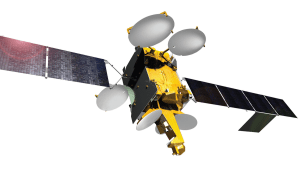Latest News
[Via Satellite 10-31-2014] Canadian satellite operator Telesat is planning a replacement satellite for Telstar 18 that might include a high throughput component. Telesat 18 entered service in August 2004 and has a 13 year lifespan. The successor satellite, to be decided upon soon, would be more powerful.
The new satellite still has many details that are not solidified. A big influencer of the future spacecraft is APT Satellite Holdings, which contributed a significant amount of funding for Telstar 18, also known as Apstar 5. APT Satellite has rights to specific transponders on Telstar 18/Apstar 5 as part of the agreement, and will help define its substitute.
“We’re working on what the design of that replacement satellite will look like right now, and we are working on it in conjunction not only with the manufacturing community but also with our partner APT as well,” said Dan Goldberg, president and CEO of Telesat, said during the company’s third quarter earnings call.
Goldberg described the C-band payload on the future satellite as “fairly like-for-like” with Telstar 18’s existing footprint, but the Ku-band payload will be more advanced.
“We expect to enter into an agreement in the coming months for a replacement satellite for Telstar 18,” he said. “This is under consideration, but certainly we’ll have a number of regional Ku-band beams that will be much higher power than the capacity on Telstar 18, and we may consider overlaying on top of that a number of more high throughput spot beams.”
Telesat is also preparing for the launch of Telstar 12 Vantage, a satellite with high throughput spot beams built to replace Telstar 12 at 15 degrees west, which entered service in December 1999. Telstar 12 has 38 Ku-band transponders covering the Middle East and North Africa (MENA), Southern Africa, most of South America and the eastern half of North America. Its successor, Telstar 12 Vantage, is equipped with up to 52 Ku-band 36 MHz equivalents, plus additional spot beam capacity. Airbus Defence and Space is building the satellite, which is slated to launch in late 2015 with Mitsubishi Heavy Industries.
Telstar 12 Vantage will have about 30 percent more throughput, according to Goldberg, thanks more so to high throughput spot beams than to an increase in transponders. The high throughput Ku-band spot beams complement traditional regional beams to provide increased flexibility in network design for new and existing customers.
“We are expecting that the traffic that’s on Telstar 12 a year from now will transition over to Telstar 12V, but there will be capacity that’s still available. We’re adding capacity over Africa on the satellite; we have different capacity over Latin America and good capacity over the North Sea, the Mediterranean and a beam over the South Atlantic,” said Goldberg.
The extra throughput provides room for Telesat to grow in new markets. As of Sept. 30, the company’s fleet utilization was 91 percent for its North American fleet and 83 percent for its international fleet. Goldberg said 81 percent of revenue came from North America, 9 percent from Latin America, 7 percent from Europe, the Middle East and Africa, and 3 percent from Asia. By market sector, broadcasting represented about 51 percent, enterprise services 47 percent, and consulting another 2 percent. Goldberg said he expects the company will enter an agreement to purchase Telstar 18’s replacement in the coming months. As of Sept. 30, Telesat’s backlog for future services was approximately $4.6 billion.
Get the latest Via Satellite news!
Subscribe Now